Karnataka 2nd PUC Biology Notes Chapter 14 Ecosystem
→ The term ‘ecosystem’ was coined by Sir Arthur Tansely (1935). It is a functional unit of nature, where living organisms interact among themselves and also with their physical environment.
→ Ecosystems vary greatly in size such as a small pond to a large forest or a sea.
![]()
→ The global ecosystems are grouped into two categories
- terrestrial or land ecosystems (e.g., forests, grasslands, deserts, gardens), and
- aquatic or water ecosystems (e.g., freshwater ponds, t lakes, wetlands, rivers, streams, estuaires, oceans). The ecosystems which develop in nature without human support or interference are called natural ecosystems.
Note: While the ecosystems created and maintained by human beings are termed as r anthropogenic or manmade ecosystems.
e.g., crop fields, aquarium, space craft.
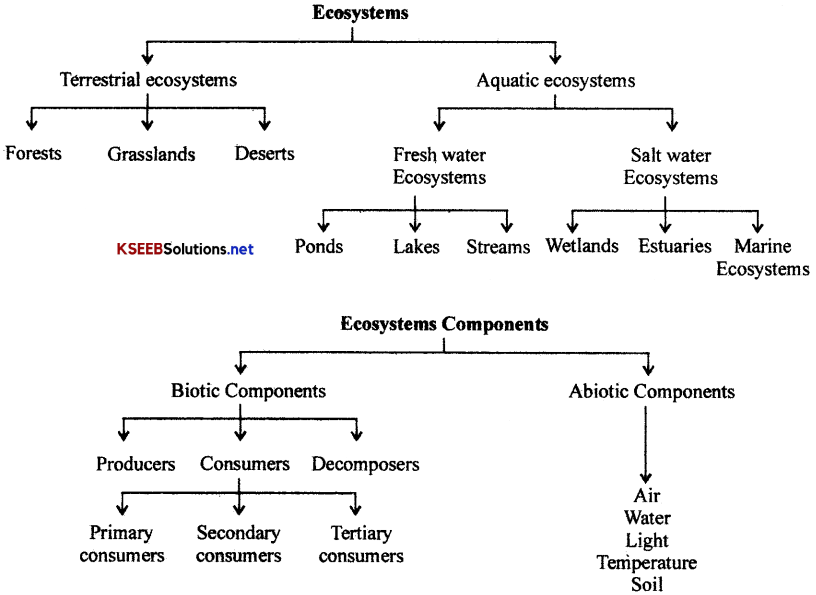
Ecosystem Structure:
The interaction of biotic and abiotic components results in a physical structure that is characteristic for each type of ecosystem. Following are the major structural features of an ecosystem:
1. Species composition: Different ecosystems have different species composition which depends upon geography, topography and climate. A great variety of species is found in tropical rainforests and coral reefs, whereas, only a few species occur in deserts and arctic regions.
2. Stratification: It is the vertical distribution of different species, occupying different levels in an ecosystem. For example, in a forest, trees occupy the top vertical strata, shrubs the second and herbs and grasses occupy the bottom layers.
3. Trophic organization: Food relationship of producers and consumers is another way to depict ecosystem structure. The producers form the first trophic level or T1, the herbivores the second or T2, and carnivores constitute the third or T3 The top carnivores belong to T4 or T5 trophic levels.
4. Standing crop: It is the amount of living material present in different trophic levels per unit area at a given time. It is generally expressed in dry weight, as the frefh weight is liable to fluctuate due to seasonal moisture.
5. Standing state: It is the amount of nutrients present anytime in the soil of ecosystem. It tends to vary from season to season and ecosystem to ecosystem.
![]()
Ecosystem Function:
The Components of an ecosystem function as a unit with a number of delicately balanced and controlled processes. The important functional aspects of an ecosystem are:
- Productivity
- Decomposition
- Energy flow and
- Nutrient cycling.
Productivity:
→ A constant input of solar energy is the basic requirement of any ecosystem to function and sustain.
→ Primary productivity is expressed in terms of gm–2 yr-1 or k Cal m-2 y-1,
→ Primary productivity has two aspects :
- Gross Primary Productivity (GPP) is the rate of production of organic matter during photosynthesis.
- Net Primary Productivity (NPP) is the amount of energy left in the producers after utilisation of some energy for respiration, i.e., GPP’ – R = NPP. It is the amount of energy available in the producers, for the consumption of herbivores.
→ Primary productivity depends on,
- the plant species in a particular area,
- availability of nutrients,
- photosynthetic capacity of plants and
- a number of environmental factors.
→ The annual net primary productivity of the whole biosphere is approximately 170 billion tons (dry weight) of organic matter.
→ Of this, the productivity of oceans is only 55 billion tons, while the rest is from land.
→ Secondary productivity is defined as the rate of assimilation and formation of new organic matter by consumers.
Decomposition:
→ Detritus is the raw material for decomposition.
→ Following are the steps in the’process of decomposition :
- Fragmentation: It is the process of breaking of the detritus into smaller particles by detritivores.
- Leaching: It is the process in which water-soluble inorganic substances run down into soil profile and get precipitated as unavailable salts.
- Catabolism: The enzymatic conversion of the detritus into simple organic compounds and then into inorganic compounds, is called catabolism. The enzymes are secreted by the decomposers like bacteria and fungi.
- Humification: Humification during decomposition leads to the accumulation of a dark coloured amorphous substance called humus.
- Mineralisation: It is the process in which the humus is degraded by certain microbes and the inorganic nutrients are released.
→ Decomposition is largely an aerobic process, i.e., it requires oxygen.
→ The factors affecting decomposition are :
- The chemical composition of detritus and
- The climatic factors.
→ If detritus is rich in lignin and chitin, decomposition is slow and it is faster if detritus is rich in nitrogen and water-soluble substances.
→ Temperature and soil moisture are the important climatic factors that regulate decomposition through their effects on the activities of soil microbes.
→ Warm and moist environment favours decomposition, while low temperature and anaerobic conditions inhibit decomposition.
![]()
Energy Flow(Food Chain):
The primary source of energy for all living organisms in ecosystem is sunlight. The only living organisms capable of converting light energy into food molecules are green plants, hence they are called producers (P). It is for the food energy that the producers are eaten by all types of consumers. The process of flow of food energy from producers through a series of consumers by repeated eating and being eaten is called the food chain. The steps or links involved in food chain are called trophic levels [T].
Trophic Level:
Trophic level is described as the nutritional level of an individual in a food chain that indicates the specific food habit, e.g. Caterpillar, grass hopper, rabbits and elephants are grouped under same trophic level since all of them are herbivores, they feed directly on plants as food source.
The green plants (producers) occupy first trophic level (T1), while the animals of C1, C2 and C3 occupy successive trophic levels namely T2, T3, T4 respectively in a food chain. At each trophic level food energy is used up for metabolic activities and only 10% of it is available for the next trophic level. Thus energy level decreases considerably at successive trophic levels. Hence smaller the food chain or less the number of trophic levels, greater will be its available energy.
Types of food chains:
There are 3 main types of food chains in nature namely,
1. Predatory food chain: It starts with green plants (producers) and proceeds from smaller animals (herbivorous) to larger animals (carnivorous). Since it involves grazing of plants by herbivores, it is also called grazing food chain. It explains predatory to prey relations. It includes the following examples.
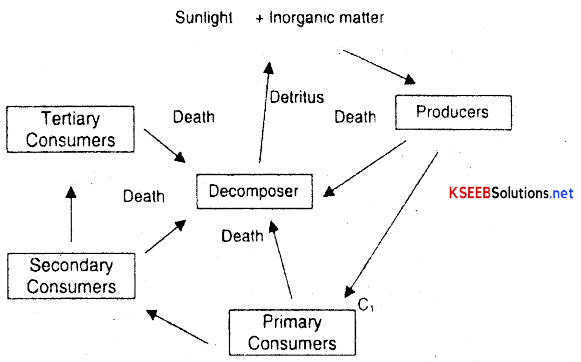
→ Pond food chain:

→ Forest food chain:
- Green plants → Deer → Tiger.
- Green plants → Rabbit → Wolf → Tiger.
→ Grass land food chain:

→ Marsh land food chain:

![]()
2. Parasitic food chains
It starts with producers and passes from larger animals (hosts) to smaller animals, (parasites). It explains host-parasite relationship. Examples:-
- Green plants → Man (Host) → Intestinal round worms (endoparasites).
- Grass → Sheep (Host) → Liver fluke (endoparasite).

- Grass → Horse → Roundworm (Ectoparasite)
3. Saprophytic food chain (Detritus food chain):
It starts with dead bodies and proceeds further from decomposers to detrivores which explains the recycling of matter, e.g. Dead bodies.
1. Dead bodies → Decomposers → Detriveres.
(Detritus) T1 (Bacteria & Fungi) T2 (Millipedes and earthworms) T3.
2. Mangroove trees → Dried leaves → Ocean → Bacteria and fungi → Crabs and Snails.
Food Web:
Food chains remain inter connected at various levels. The web like inter locking system of several food chains in a community is called food web, This maintains ecological homeostasis. It allows an organism to feed on two or more organisms of the lower trophic level and provides for survival of organisms.
Ecological Pyramid:
→ It is the graphic representation of trophic structure and function of a food chain. It is so called due to its superficial resemblance to Egyptian pyramid. The Pyramid concept in ecology was proposed by Charles Elton and hence they are also called Eltonian pyramids.
→ It is usually broad below and tapering to on apex above. Producers occupy the broad base, while animals are consumers occupy successive steps tapering into the apex of the pyramid. There are 4 types of ecological pyramids namely.
1. Pyramid of Number:
It is graphic representation of numerical relationship between successive trophic levels „ in a food chain. Usually it is an upright pyramid and it illustrates decreasing number of individuals at successive trophic level from producers to consumers. Number of individuals is maximum in producers compared to consumers, e.g.: Pond food chain.

Pyramids numbers. (A) In a grassland ecosystem. (B) in a pond ecosystem
![]()
2. Pyramid of Biomass:
It is graphical representation of biomas at successive trophic level in a food chain. Biomas is the total dry weight of an organism or all organisms of a trophic level. It is expressed as pounds or kilograms. Usually it is an upright pyramid and illustrates decreasing biomas at successive trophic levels from producers at the base to the consumers. Biomas of producers is maximum. It is less in Consumers, e.g.: Pond food chain.
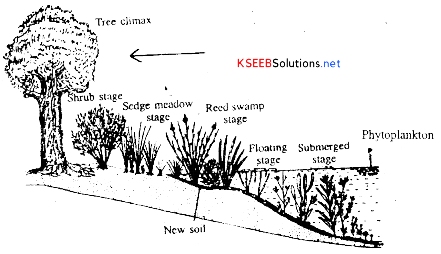
3. Pyramid of Energy:
It is graphic representation of available energy at successive trophic levels in a food chain. Energy level is expressed as kilocalorie. It is the typical upright pyramid. It illustrates decreasing energy level at successive trophic levels from producers at the base to the consumers. Energy level is maximum in producers, less in consumers, e.g.: Pond food chain.
4. Pyramid of a parasitic food chain (Inverted Pyramid):
In the case of parasitic food chain the pyramid of number becomes inverted, e.g. A single large tree (T1) feeds and shelters several fruit eating birds (T2). They further feed and shelter many ecto parasites (ticks & fleas) T3. These in turn, feed and shelter numerous hyperparasites (Bacteria and fungi) T4. Thus it indicates the increasing number of individuals at successive trophic level from base to apex resulting in an inverted pyramid with tapering base below and broad apex above.
Ecological or Biotic Succession:
→ The occurrence of relatively definite sequence of communities over a long period of time in the same area resulting in establishment of stable or climax community is known as ecological or biotic succession.
→ The first community which inhabits the area will be referred to as ‘pioneer community’ and the last and stable community formed in the area will be referred to as ‘climax community’. The intermediate communities are called ‘transitional or serai communities’. The whole series of changes in community characteristics from pioneer stage to climax stage constitutes a ‘sere’ and the intermediate stages are the ‘serai stages’.
→ Usually the initial stages of succession are comprised of lower forms.
→ Causes of ecological succession are classified under two categories: Biotic Factors and Physiographic Factors.
→ Interactions among the organisms in a community, called as biotic factors, influence the structure, composition and function Of a community. In succession, over a period of time a community makes the area less favourable for itself and more favourable for the next serai community .
→ Physiographic factors include physical and chemical factors of the environment such as landslides, erosion, catastrophic factors, etc.
→ Basic types of succession : primary succession and secondary succession.
![]()
Primary successio :
→ It is also referred as ‘perisere’. It is a type of biotic succession that occurs on a substratum devoid of life earlier like bare rock, sand dunes, new island exposed out of the sea etc, where there was previously no life forms.
→ Primary succession takes a very long time (more than thousands of years in case of climax forest on bare rock). Process of primary succession occurs through a number of sequential steps, which follow one another. They are nudation, invasion, migration, ecesis, aggregation, competition, reaction, and stabilization.
Secondary successions:
→ It is the biotic succession that occurs in an area, which had an existing biotic community and has become bare due to destruction by fire, landslide, earthquake etc.
→ The sequence of successional stages is called ‘subsere’, and time required for the completion of sere is much shorter than primary succession.
Stages of Ecological Succession in a Hydrosere:
It involves the ecological succession in a newly formed pond, lake (or any open water areas) and successional series progress from hydric to the mesic conditions. It involves the following ecological succession.
→ Pioneer stage: The pioneers are phytoplankton consisting of unicellular and colonial forms of green algae near the surface of water. They are followed by zooplanktons like Amoeba, Paramecium and Vorticella. Death and decomposition of phytoplankton and zooplankton produces organic matter which mixes with the silt and form a soft mud which favours the growth of next stage of plants.
→ Submerged stage: In a pond or lake, where water is less than 10 feet deep, there may be entirely submerged and free floating plants and some submerged and rooted at the bottom, e.g., Hydrilla, Vallisneria, Elodea, Ceratophyllum etc.
Death and decay of these plants and dead materials sinking to the bottom and addition of sand and silt around the plants results in rise of soil at the bottom. This makes the pond or lake more shallow and unsuitable for the submerged species but suitable for rooted floating plants.
→ Floating stage: It consists of rooted hydrophytes with roots, rhizome or root stock attached at the bottom of the pond. Some of these plants have their leaves spread over the surface of water while some have free floating leaves e.g., Nymphaea, Nelumbo, Trapa, Salvia, Azolla etc. The large leaves of many of these plants cut off light to the submerged plants. Hence with very little light it becomes unsuitable for the growth of submerged plants. It results in building up of the bottom of the pond or lake and the edges become more shallow (1 – 3 ft).
→ Reed swamp stage : In shallow water marshy plants like Typha, Rumex, Sagittaria invade and establish. These plants are rooted at the bottom and are partly submerged but their shoots

extend well above the water. They cut light from the floating plants and they find it less favourable. Such plants die adding the organic matter to the soil. In course of time, the edge of the pond or lake is converted into water – saturated place (marshy place) favourable for the marsh – meadow stage.
→ Marsh – meadow stage (Sedge – meadow stage) Marshy edges with one or two inches of water of ponds or lakes favour the growth of members of family Cyperaceae and Gramineae such as Carex, Cyperus, Juncus, Eleocharis, Fucus, sedges and tall grasses, forming a meadow (mat) like vegetation. Slowly the surface water dries up and develops a mesic condition in the area and the marshy vegetation disappears gradually.
![]()
→ Woodland stage: In the moist climate, the woodland stage consists of shrubs and small trees like salix (shrubby willows), populus (cotton wood) and tree willows. The pioneers of this will be those that can tolerate partial water- lodged conditions around their roots. The woody plants in the region cast shade and make the soil dry by their vigorous transpiration and holding the wind – borne soil and accumulating plant debris. Mineralization and soil formation favours the growth of herbs among the shrubs and trees.
→ Forest stage: It is the climax stage during the course of time, in which the soil becomes rich in humus and organic matter and supports climax community. It may be tropical deciduous or monsoon forests in regions of moderate rainfall, tropical rain forests in areas with heavy rainfall and mixed forests of Quercus (oak), Acer and Alnus in temperate regions.
Stages of Ecological Succession in a Lithosere (XERARCH):
- It is a type of xerosere that involves the ecological succession on bare rock surfaces.
- Rocky surface is characterized by, deficiency of water, absence of organic matter and very high surface temperatures.
Stages of lithosere:
→ Crustose lichen stage: It forms the pioneer community in a lithosere and is represented by lichen species like Lacanora, Graphis, Rhizocarpus and Rinodina. These are resistant to dessication and high temperature. They produce organic acids which cause weathering of rocks so that minerals essential for further growth of lichens are released. The lichens hold the fine particles of rock along with the sand particles bought by wind in the depressions to initiate soil formation.
→ Foliose – lichen stage: The change in the rock made by the crustose lichens makes possible for the growth of foliose lichens such as Parmelia and Physcia. Their expanded thalli cover the crustose lichens which finally die and decay. Water and humus collect around the foliose lichens and the acids produced by them eat into the rock. It leads to the development of a fine soil layer on the rock surface which favour the growth of mosses.
→ Moss Stage: The accumulation of soil and humus as a thin layer on the surface of rock results in the growth of mosses like Poly trichum and Grimmia. These mosses being taller and gregarious, kill the lichens with their shade and replace them. Mosses break up, the rock further arid their bodies are added to the soil, increasing its thickness, fertility and water holding capacity.
→ Herb stage: The mat formed by mosses in the partially fragmented rock surface has greater water holding capacity. Many herbs, short lived annual, biennial and perennial and
xerophytic grasses make their first appearance. The roots of these plants accelerate the process of rock disintegration. The amount of soil increases as the death and decay of these increases the humus.
→ Shrub stage: The thick layer of soil with humus results in the growth of shrubs like Rhus, Zizyphus, Caparis etc. the roots of the shrubs further erode the rock which is more or less completely covered with soil. The soil is further enriched by humus formed from fallen leaves and twigs. All these conditions are favourable for the growth of trees.
→ Tree stage: It is the climax community in lithosere. The first tree species to appear are stunted and are spaced afar. Further weathering of rocks and increasing humus content of the soil favours the growth of more trees. The vegetation finally becomes mesophytic. It may result in a rainforest in a moist tropical area, coniferous forest or deciduous forest in temperate area and a grassland in area with less rainfall etc.
Bio-Geo Chemical Cycles / Nutrient Cycling (Inorganic – Organic Cycles):
They are the cyclic movements of essential chemical elements between the environment and
living organisms, establishing relationship among living organ isms, soil and chemical elements. It can also be defined as the specific circulation of inorganic matter / gases between the living and the non-living world.
I. Classification Based on the Type of Inorganic Matter:
1. Gaseous cycles : It refer to cycling of gases like carbon, nitrogen and oxygen between the environment and living organisms since their reservoir is atmospheric air. They are called gaseous cycle. They include carbon cycle, nitrogen cycle and oxygen cycle respectively.
2. Sedimentary cycle : They refer to cycling of mineral elements (Nutrients) between the environment and living organisms and hence they are also called nutrient cycles. Their reservoir is soil or sedimentary rocks. They include sulphur cycle, phosphorous cycle and calcium cycle.
![]()
II. Classification Based on the Efficiency of Circulation
1. Perfect cycle: Here, the inorganic – organic cycle is perfect, such that there is maximum utility and minimum wastage e.g. Carbon cycle.
2. Less perfect cycle : Here the inorganic – organic cycle is with the involvement of intermediate compounds such that there is moderate utility and wastage is observed, e.g. Nitrogen cycle.
3. Imperfect cycle: Here the inorganic – organic cycle is with the involvement of sedentary reservoirs, such that there is maximum wastage and minimum utility, e.g. Sulphur cycles, phosphorous cycles.
Carbon Cycle:
It is the cycling of carbon or carbon dioxide between the environment and living organisms. It is a type of gaseous cycle and it occurs as carbon dioxide in air and also dissolved in water. It is referred as the gaseous perfect cycle.
Green plants (producers) fix the carbon of the atmospheric carbon dioxide by photosynthesis and incorporate it in their food molecules as carbohydrates. Animals (Consumers) obtain the same from plants by feeding on them directly (Herbivorous) or indirectly (Carnivores) and incorporated in their organic substances as carbon skeleton.
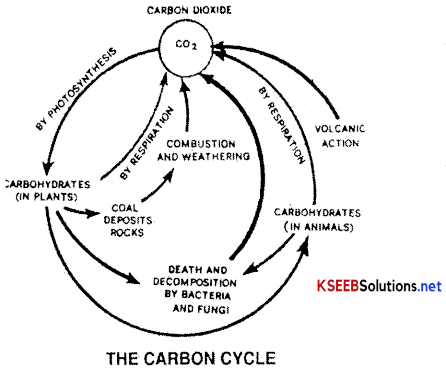
It is in the same way that the dissolved carbon dioxide of water is used by aquatic plants and passed on to aquatic animals through*food chains. The carbon of organisms eventually returns to the atmosphere as carbon dioxide by the following events.
- During respiration in both plants and animals.
- During bacterial decomposition of dead bodies of plants and animals.
- Combustion of fossilized plant products such as coal and oil deposits and forest fires.
- Volcanic explosions.
![]()
Phosphorous Cycle:
It is cyclic movement of phosphorous as a nutrient between the environment and living organisms. It is sedimentary cycle. Its main reservoirs in nature are phosphate rocks, fossil bone deposits and guano deposits (hardened excreta of marine birds) from them, by weathering and volcanic eruptions. Phosphorous is released as inorganic phosphates into the soil and water. Much of these phosphates get washed into the sea where they are lost into deeper sedimentation.
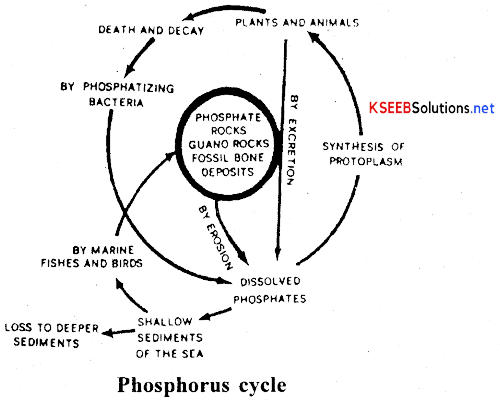
Only some phosphates of soil and water are absorbed through roots by green plants (producers) and are used to form the important components of protoplasm, cell membrane, ATP and nucleic acids. These are obtained by animals (consumers) as they feed on producers directly (herbivores) are indirectly (carnivores) through food chains. In animals phosphorous is essential for teeth and bone formation. Bacterial decomposition of dead bodies of producers and consumers return the phosphorous as phosphates to the cycle to be recycled through organisms. Since much of the soil phosphates are lost to sedimentation leaving only some to be cycled through the organisms, phosphorous cycle is a good example for imperfect bio-geo chemical cycle.
Ecosystem services:
Ecosystem services are
- Healthy forest ecosystems purify air and water.
- Mitigate droughts and floods.
- Cycle help in nutrients.
- Generate fertile soils.
- Provide wildlife habitat.
- Maintain biodiversity.
- Help to Pollinate crops.
- Provide storage site for carbon and also provide aesthetic, cultural and spiritual values.